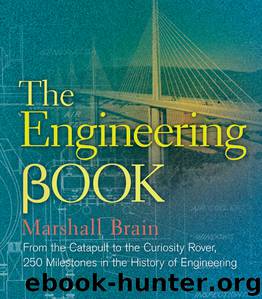The Engineering Book by Marshall Brain

Author:Marshall Brain
Language: eng
Format: epub
Publisher: Sterling
This photo shows irradiated strawberries (left) and normal strawberries (right) after several days.
1964
Top Fuel Dragster
What if you let engineers take technology to the limit? You let them evolve everything with a single goal in mind. That is what has happened in top fuel drag racing to get us to the cars we see today. Engineers want to make the fastest piston-engine vehicle possible. How far can the car evolve to make that happen?
One way is to grow the engine’s power. Engineers start with a 500-cubic-inch (8.2 liter) V-8—the largest allowed under National Hot Rod Association (NHRA) rules. They add a supercharger to cram as much air as possible into each cylinder. Then they change the fuel, from gasoline to nitromethane, aka “top fuel.” Nitromethane is more a liquid explosive than a fuel and was first allowed in the 1964 season. It contains quite a bit of the oxygen it needs to burn within the molecule itself (a characteristic of an explosive). The amount of fuel injected is staggering. Think of the water coming out of your showerhead in the morning. Each cylinder is receiving fuel at that kind of rate. The engine can burn 1.3 gallons (5 liters) of fuel per second.
Then grow the rear tires. They are incredibly wide to create the largest possible contact patch, and they use “wrinkle wall” technology to make the contact patch even longer at the starting line. The wing provides 8,000 pounds of downforce to keep the tires glued to the track once the car gets moving.
The power gets from the engine to the tires through a complex six-stage clutch that can provide a lot of slip at the start, and progressively less slip as the car comes up to speed. It is a direct-drive system with no transmission—clutch slip keeps the engine from bogging down. Getting the clutch parameters right is one of the most important aspects of the car’s setup.
All of this technology means the engine makes 8,000 horsepower (6 megawatts), and the car has gigantic acceleration. When the light turns green, the car goes from zero to 75 mph (120 kph) in half a second, using approximately 20 feet (6 meters) of track to do it. By the end of the quarter mile the car is going over 300 mph (480 kph).
SEE ALSO Supercharger and Turbocharger (1885), Internal Combustion Engine (1908), Formula One Car (1938).
Download
This site does not store any files on its server. We only index and link to content provided by other sites. Please contact the content providers to delete copyright contents if any and email us, we'll remove relevant links or contents immediately.
| Automotive | Engineering |
| Transportation |
Whiskies Galore by Ian Buxton(41718)
Introduction to Aircraft Design (Cambridge Aerospace Series) by John P. Fielding(33016)
Small Unmanned Fixed-wing Aircraft Design by Andrew J. Keane Andras Sobester James P. Scanlan & András Sóbester & James P. Scanlan(32684)
Craft Beer for the Homebrewer by Michael Agnew(18081)
Turbulence by E. J. Noyes(7893)
The Complete Stick Figure Physics Tutorials by Allen Sarah(7264)
Kaplan MCAT General Chemistry Review by Kaplan(6822)
The Thirst by Nesbo Jo(6758)
Bad Blood by John Carreyrou(6476)
Modelling of Convective Heat and Mass Transfer in Rotating Flows by Igor V. Shevchuk(6353)
Learning SQL by Alan Beaulieu(6158)
Weapons of Math Destruction by Cathy O'Neil(6084)
Man-made Catastrophes and Risk Information Concealment by Dmitry Chernov & Didier Sornette(5877)
Digital Minimalism by Cal Newport;(5586)
Life 3.0: Being Human in the Age of Artificial Intelligence by Tegmark Max(5404)
iGen by Jean M. Twenge(5322)
Secrets of Antigravity Propulsion: Tesla, UFOs, and Classified Aerospace Technology by Ph.D. Paul A. Laviolette(5237)
Design of Trajectory Optimization Approach for Space Maneuver Vehicle Skip Entry Problems by Runqi Chai & Al Savvaris & Antonios Tsourdos & Senchun Chai(4957)
Electronic Devices & Circuits by Jacob Millman & Christos C. Halkias(4865)
